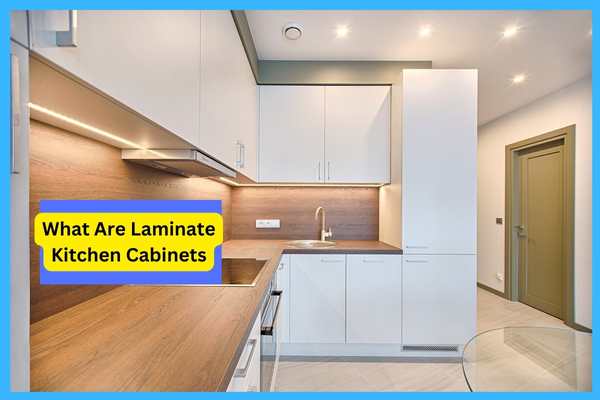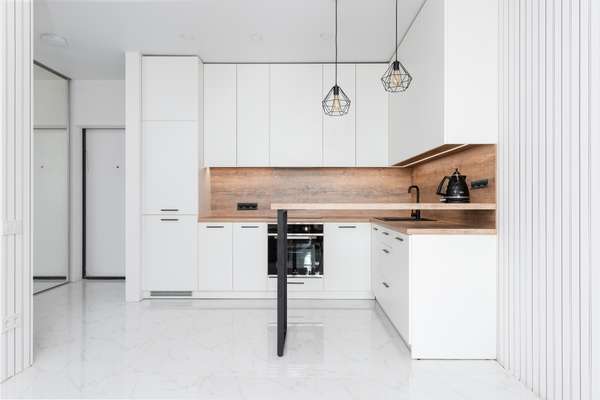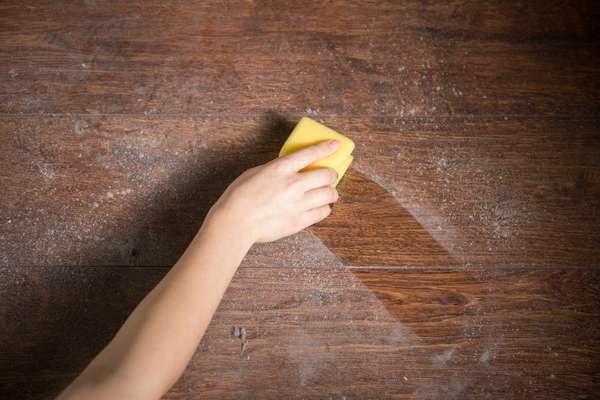Laminate kitchen cabinets are a great addition to any home. They are affordable, easy to maintain, and look fantastic. However, over time they can become dirty and grimy due to everyday wear and tear. To keep them looking good as new, regular cleaning is essential. Fortunately, clean laminate kitchen cabinets is a fairly easy process that requires minimal effort and materials. With the right strategy and supplies, you can keep your laminate cabinets looking like new for years to come
What Are Laminate Kitchen Cabinets?

These cabinets are a type of cabinet made from a thin layer of plastic laminate material that applies to a particleboard or plywood substrate. This type of cabinet is popular for its affordability and wide range of colors, textures, and finishes. The main advantage of laminate cabinets is that they are easy to clean and maintain, as well as being highly durable. They also offer great value for money, as they can install relatively quickly and easily compared to other types of cabinets. Additionally, they are relatively lightweight compared to wood or metal options, making them easy to move around in the kitchen when necessary.
What Is The Best Cleaner For Laminate Cabinets

The best cleaner for laminate cabinets is a mild detergent. A mixture of warm water and dish soap should use to clean the surface of the laminate kitchen cabinets. Make sure to avoid abrasive cleaners and harsh chemicals, as these can damage the finish of your cabinet.
When cleaning your cabinets, use a soft cloth or microfiber mop to avoid scratching the surface. Use a damp cloth or sponge to apply the detergent mixture and then wipe down with a dry cloth afterward. If you need to remove tough stains, you can use a non-abrasive scrubbing pad with the detergent solution.
It’s important to keep in mind that cabinetry is not waterproof, so you should try to avoid getting it too wet when cleaning. Additionally, make sure that any spills clean up quickly and thoroughly, as they can cause discoloration and staining if left unchecked.
Determine What Kind Of Laminate Cabinets You Have
To determine what kind of laminate cabinets you have, look for clues in the cabinetry materials and construction.
First: Examine the surface of the cabinets. If it has a glossy finish that looks like plastic or vinyl, then your cabinets are likely made from laminate. Laminate is a synthetic material made up of several layers of paper or fabric bonded together with resin.
Second: check the edges and corners of the cabinets to see if they have finish with a plastic trim piece. This is another tell-tale sign that your cabinets are made from laminate. Also, look at the backside of the cabinet doors to see if there is a thin layer of wood veneer over the top. If so, this indicates that your cabinets are likely constructed with particleboard covered in laminate.
Finally: take note of any hardware used on the cabinets such as hinges or drawer pulls.
Types Of Laminate Kitchen Cabinets
1. Matte Finish

Matte finish laminate cookhouse cabinets are becoming increasingly popular, and there are a variety of styles and colors available to suit any taste. These types of cabinetry provide a sleek and modern look that is sure to make any kitchen stand out. The matte finish on these types of cabinets creates an understated elegance that can’t achieve with glossier finishes. It has just enough shine to bring out the unique character of each cabinet without being overpowering or gaudy. And because they aren’t as reflective, they won’t distract from other decorative elements in the room like bolder countertops or appliances. Additionally, matte finishes tend to hide fingerprints better than glossy options which makes them easier to keep clean and maintain over time.
2. Acrylic Laminate

Acrylic laminate is a common material used in kitchen cabinets because of its durability and affordability. This type features a glossy, smooth surface that can enhance with shimmering metallic finishes or simple matte colors. Acrylic laminates are created by applying thin layers of plastic over a core material such as particleboard, medium-density fiberboard (MDF), or plywood. This type is available in an array of textures and finishes to suit many types of kitchen cabinetry, from modern to traditional styles.
3. Textured Laminate

Textured laminate is a popular choice for kitchen cabinets due to its attractive and versatile finish. Whether you’re looking for something modern or traditional, there are several types of textured laminates available. Here’s an overview of the different types of kitchen cabinets so you can choose the right one for your home.
High-gloss laminate is the most common type of texture used in kitchen cabinets. This type gives off a glossy, reflective surface that works well in contemporary spaces and adds depth to darker colors. Matte finish laminates have a softer, less shiny look that won’t show fingerprints as easily as high-gloss finishes do – making them ideal for homes with children and pets.
4. Veneered Laminate

Veneered laminate is a type of kitchen cabinet that has become increasingly popular in recent years. It consider a cost-effective and attractive alternative to wood or painted cabinet. Veneered offers several advantages over other types of kitchen cabinetry, including its durability and ability to withstand high temperatures. In addition, it is easy to maintain and comes in a variety of styles and finishes that can complement any decorating style.
What Cleaning Products Work Best On Laminate Cabinets?
When it comes to clean laminate kitchen cabinets, there are a few products that work best. The first is a mild dish soap and warm water solution. This is the safest option for the cabinet as it will not damage the surface. Simply mix a few drops of mild dish soap with warm water in a spray bottle and use a soft cloth to wipe down the cabinets.
Another option for clean laminate kitchen cabinets is white vinegar and warm water. This solution works well for removing grease and grime from the surface of the cabinet. Simply mix equal parts white vinegar and warm water in a spray bottle and use a soft cloth to wipe down the cabinets.
Finally, you can also use rubbing alcohol on the cabinet. This solution is great for getting rid of tough stains and discoloration on cabinet surfaces. Just make sure to dilute the rubbing alcohol with equal parts water before using it on your cabinets.
Directions For Cleaning Laminate Cabinets:
Dust Your Cabinets

When clean your laminate kitchen cabinets, dusting should be the first step. Not only does it help keep your cabinets looking clean and stylish, but it also prevents dirt and grime from gathering on them. Dusting is simple and straightforward; all you need are a few supplies to get started.
To properly dust your cabinet, start by using a dry cloth or microfiber duster to wipe down the surfaces of the cabinet doors and drawers. Pay special attention to any areas that have accumulated dirt or residue as these may require some extra effort to remove. After wiping down the exterior of your cabinet with a rag or duster, use a vacuum or soft-bristled brush attachment to remove any lingering dust particles in hard-to-reach locations such as corners or crevices.
Wipe With Soap Or Cleaner

Soap and water are all that is needed when cleaning most laminate surfaces. Start by wiping down the cabinet with warm soapy water using a soft cloth or sponge. Make sure to rinse off any soap residue before drying with another soft cloth or paper towel. This prevents streaking on the surface of the cabinet. For tougher dirt and stains. Use specially formulated cleaners made for laminate surfaces to avoid damaging the material’s finish over time. Before applying the cleaner, make sure all food particles and other debris have wipe away from its surface.
Rinse And Dry

Rinse and dry is an important step in the direction of cleaning laminate cabinets. This is a common feature in many homes, usually found in the kitchen or bathroom, providing both form and function. To keep this cabinet looking its best, regular care and maintenance require. Using a soft cloth or sponge, lightly scrub away any dirt or debris that may have built up over time. After this initial rinse, use a damp rag to thoroughly wipe down the surface of the cabinet from top to bottom. Be sure not to soak the cabinet by using too much moisture during this step; it should be damp but not wet.
Wipe Down Surfaces With A Dry Cloth

Knowing how to properly wipe down surfaces with a dry cloth is an important step in the process. These directions provide details on the best way to use a dry cloth when cleaning laminate cabinets. Begin by using a slightly damp microfiber cloth or other lint-free cloth and wiping down the entire surface of each cabinet. This should do gently. Circular motions, working your way from top to bottom and left to right across each cabinet door and drawer front. Once you’ve covered the entire surface, follow up with a dry microfiber or lint-free cloth for buffing out any water spots that may have been left behind from the damp cloth. Make sure to use light pressure so as not to damage the glossy finish of your cabinet.
Tackle Stains With Baking Soda

Baking soda is a great alternative that can help tackle tough stains with ease. This safe and natural cleaner can use in several ways to bring your laminate cabinet back to life. Mix two parts baking soda with one part water to form a paste. Using a soft cloth, rub this paste onto the stain until it starts to dissipate. If necessary, use a toothbrush or other small brush for hard-to-reach areas. After all of the residues have removed. Rinse off the area with warm water and dry thoroughly with another cloth. Clean Kitchen Cupboards With Vinegar
Avoid Abrasive Materials

Abrasive products can damage laminate surfaces and leave scratches that are difficult to remove. To get your cabinet looking its best, here are some directions for cleaning cabinets without using abrasive materials. When scrubbing tough spots on the surface, be sure to use a non-abrasive scrub pad or brush with a mild detergent solution instead of steel wool pads or other abrasive cleaners. After cleaning. Dry the surface immediately with a soft cloth or paper towel in order to prevent water spots from forming on the cabinet’s finish.
Home Remedies Should Avoid
Home remedies have been around for centuries as a way to clean and care for our homes without the use of harsh chemicals. Many people believe that natural, homemade recipes can be just as effective as store-bought products, however, this isn’t always the case. When it comes to cleaning laminate cabinets, certain home remedies should be avoided in order to maintain their quality and appearance over time.
Cleaning laminate cabinets requires special care since they are particularly prone to water damage. Vinegar is tout as an all-purpose cleaner, however, it should not use on cabinets because it is too acidic and can cause discoloration or warping. Similarly, abrasive materials such as steel wool should not use either; instead, opt for soft cloths or sponges when cleaning your cabinets.
A Cleaner And More Organized Kitchen

A Cleaner And More Organized Kitchen: Having a clean and organized kitchen does not have to be hard. With the right cleaning practices, your laminate cookhouse cabinet can stay looking fresh and inviting.
Start by wiping away any dirt or dust with a damp cloth. Then, use an all-purpose cleaner to get rid of any grease and grime that may have built up over time. Be sure to rinse the surface with water afterward and dry it thoroughly before applying a sealant designed for laminate surfaces. This will help protect your cabinet from future damage caused by moisture or heat.
Once you’ve properly cleaned your laminate kitchen cabinet, it’s time to organize them in a way that makes sense for you and your family. Rearrange items so they are accessible when needed and discard anything that is no longer useful or necessary.
Benefits Of Laminate Kitchen Cabinets Clean
Laminate cookhouse cabinets provide a cost-effective, stylish solution when you’re looking to update the look of your kitchen. Not only are they budget-friendly but with proper care and maintenance, They are easy to keep clean and look new. Here are some benefits of a clean laminate kitchen cabinet that you should consider for your next home remodel project.
One of the most significant advantages of choosing laminate cabinetry is its resistance to moisture and dirt. Unlike wood cabinetry, which can easily become warped from water damage. Laminate surfaces feature a hard plastic layer that provides superior protection against spills or debris. Cleaning is also much easier as all it requires is a damp cloth and mild soap or detergent; no special cleaners are necessary.
Learn how to remove a kitchen sink drain with this step-by-step guide. Find out the tools and supplies needed, as well as tips for making the process easier.
The Final Thoughts
Cleaning laminate kitchen cabinets is an important part of home upkeep and maintenance. With the right tools and cleaning materials, keeping your kitchen cabinets looking their best can achieve with relative ease. Remember to use caution when using harsh chemicals or cleaning solutions, always test them in an inconspicuous location first. Regular dusting and wiping down surfaces will help keep away dirt and grime while providing a longer lifespan for your cabinets.
